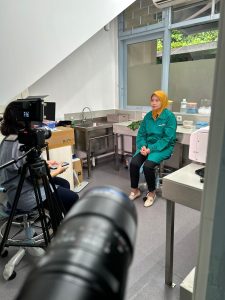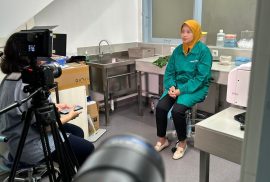 Cassava is a root vegetable with several benefits, from the root to the leaves. The most frequent part of being consumed is the root, which is mainly consumed as steamed, boiled or fried cassava. The leaves are commonly found in Indonesian cuisine as side dishes served with rice and rendang meat or cooked with coconut milk as “gulai”. In some parts of rural districts in Indonesia, cassava has been processed as a rice substitute for a long decade since the rice is commonly pricey for the villagers or cannot be cultivated as frequently as cassava. In general, rice can be harvested twice a year, sometimes three times at the most, while cassava is possibly more than that. The other benefit of cassava is that it has a lower glycemic index but is rich in carbohydrates, which is potentially better than rice for people with diabetes. Cassava roots are also a good source of vitamin C, which is good for immunity, and resistant starch, which is good for the gut, improving blood sugar management and increasing feeling of fullness, which is good for people with obesity to control their appetite and body weight. Not only the health benefits, but cassava consumption also needs to be encouraged as the staple food substitute to increase diversification. Since the rice dependency in Indonesia is growing while the rice production may not be sufficient for the entire population, alternative food needs to be introduced, and cassava can play the role of a main character.
Cassava is a root vegetable with several benefits, from the root to the leaves. The most frequent part of being consumed is the root, which is mainly consumed as steamed, boiled or fried cassava. The leaves are commonly found in Indonesian cuisine as side dishes served with rice and rendang meat or cooked with coconut milk as “gulai”. In some parts of rural districts in Indonesia, cassava has been processed as a rice substitute for a long decade since the rice is commonly pricey for the villagers or cannot be cultivated as frequently as cassava. In general, rice can be harvested twice a year, sometimes three times at the most, while cassava is possibly more than that. The other benefit of cassava is that it has a lower glycemic index but is rich in carbohydrates, which is potentially better than rice for people with diabetes. Cassava roots are also a good source of vitamin C, which is good for immunity, and resistant starch, which is good for the gut, improving blood sugar management and increasing feeling of fullness, which is good for people with obesity to control their appetite and body weight. Not only the health benefits, but cassava consumption also needs to be encouraged as the staple food substitute to increase diversification. Since the rice dependency in Indonesia is growing while the rice production may not be sufficient for the entire population, alternative food needs to be introduced, and cassava can play the role of a main character.
Penelitian
Tawaran Penelitian Hibah Penelitian Mahasiswa Departemen Gizi Kesehatan FK-UGM 2017
| Agenda | Jadwal |
|---|---|
| Batas Akhir Penerimaan Proposal | Senin, 6 Maret 2017 |
| Seleksi Proposal | Senin-Jumat, 13-17 Maret 2017 |
| BPengumuman Proposal lolos seleksi | Senin, 27 Maret 2017 |
Siti Helmyati1,Mohammad Juffrie2,Endang Sutriswati Rahayu3,BJ. Istiti Kandarina4
1Department of Nutrition, Faculty of Medicine, UGM, Yogyakarta
2Department of Child Health, General Hospital Dr. Sardjito, Yogyakarta, Indonesia
3Faculty of Food Technology, UGM, Yogyakarta
4Department of Public Health, Faculty of Medicine, UGM, Yogyakarta
ABSTRACT
The role of gut microbiota in human health is highly understandable. Recent research highlights the influence of geographical terms in gut microbiota composition. Unfortunately, baseline data of microbiota composition in children are limited. We compared the number of fecal microbiota of children, ages 9-12 years, living in Kulon Progo (KP), Yogyakarta with same age children in West Lombok (WL), West Nusa Tenggara. The study was an observational study with comparative design.
Susetyowati,
Department of Nutrition and Health, Faculty of Medicine Gadjah Mada University,
Farmako Street, Sekip Yogyakarta 55281, e-mail: susetyowati@ugm.ac.id
Background.
Malnutrition in hospitalized patients is considered as a significant problem, thus nutritional screening should be performed in all patient on hospital admission.In Indonesia was developed nutrition screening tool, namely the Simple Nutrition Screening Tool (SNST) which was valid and reliable. The objective of this study was to compare the SNST and Nutrition risk screening-2002 (NRS-2002) against the Subjective Global Assessment in patients admitted to Sleman District Hospital.
Siti Helmyati1*, Narendra Yoga Hendarta2, Endri Yuliati1
1Department of Nutrition, Faculty of Medicine, Universitas Gadjah Mada, Yogyakarta, Indonesia
2Health Analyst, Polytechnic of Health, Ministry of Health, Yogyakarta, Indonesia
*Corresponding author: siti_helmyati@yahoo.com
Abstract
Lily Arsanti Lestari1,*,Marsetyawan HNE Soesatyo2, Susi Iravati3, Eni Harmayani4
1Department of Nutrition and Health, Faculty of Medicine, Gadjah Mada University, Jl. Farmako, Sekip Utara, Yogyakarta, Indonesia
2Department of Cell Biology and Histology, Faculty of Medicine, Gadjah Mada University, Jl. Farmako, Sekip Utara, Yogyakarta, Indonesia
3Department of Microbiology, Faculty of Medicine, Gadjah Mada University, Jl. Farmako, Sekip Utara, Yogyakarta, Indonesia
4Department of Agricultural Product Technology, Faculty of Agricultural Technology, Jl. Flora, Bulaksumur, Yogyakarta, Indonesia
* Corresponding author: lily_al@ugm.ac.id / santi_wap@yahoo.com
Toto Sudargo, Hamam Hadi, Wiryatun Lestariana, Amitya Kumara
Faculty of Medicine and Faculty of Psichology Gadjah University , Indonesia
Siti Helmyati1, Narendra Yoga Hendarta2, Septi Puspitasari3, Rochyana Imami3
Abstract: This study was conduct to identify the stability of salt double fortification with iron from NaFeEDTA and iodine from potassium iodate (KIO3) at different storage condition, open and closed condition. This research is pure experiment research use pre post with control design. There are 4 unit examinations (1 control group and 3 treatment groups). There are 4 concentration variation of NaFeEDTA 0%;0.02%; 0.05%; 0.1%. All examination units were stored for 1 month (28 days) at opened and closed storage. Iodine level was analyzed with iodometry titration method at day 0, 7, 14, 21, and 28.Results showed that Iodine retention after 28 days storage is decline. For close storage iodine retention on NaFeEDTA 0 %;0,02 %;0,05 %; dan 0,1 % are 83,40 %; 82,96 %; 84,33 %; 82,62 % constantly. For open storage are 61,76%, 60,59%, 69,48% and 76,76%. Statistic test show that there no efffect (p>0,05) on variation of NaFeEDTA concentration with stability of iodine.
Mirza Hapsari Sakti Titis Penggalih1
Abstract
Hot temperatures increase the risk of dehydration. Fluid can prevent dehydration. It should contain electrolytes with certain osmolarity. Banana isotonic drinks (BID) was developed. This study aims to determine the difference effect of BID and plain water (PW) of body hydration. Experimental research with a cross over design was involving 16 subjects. It divided into two groups. After undergoing two days of quarantine, each subject administrated 500 ml of fluid. Wash-out period between treatments was 7 days. Indicator of hydration of hemoglobin, HCT, blood volume and urine are assessed before and after intervention. The result showed that indicator of hydration differed significantly after receiving the intervention (P <0.05) although there was no difference between groups (P> 0.05). However, urine volume formation was higher on the AP. BID is able to improve the hydration of the body through the mechanism of maintaining body volume and slowing down the urine formation.


